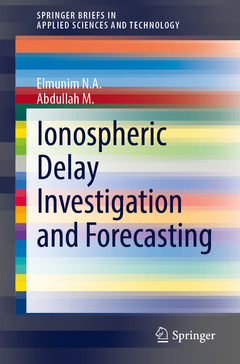Description
Ionospheric Delay Investigation and Forecasting, 1st ed. 2021
SpringerBriefs in Applied Sciences and Technology Series
Authors: Elmunim N. A., Abdullah M.
Language: English
Subjects for Ionospheric Delay Investigation and Forecasting:
68.56 €
In Print (Delivery period: 15 days).
Add to cartSupport: Print on demand
Description
/li>Contents
/li>Biography
/li>Comment
/li>
This book highlights ionospheric delay investigation and forecasting using GPS-TEC measurements in the equatorial region. The ionospheric delay error is the main source of error and a major concern for GPS applications as it corrupts the positioning and time transfer results. In the equatorial region, the variations of the total electron content (TEC) and the ionospheric delay are recognized to be high when compared with other regions such as mid-latitude and high latitude. The investigation and forecasting of trans-ionospheric propagation errors are essential for precise measurement and further contribute valuable information to satellite and space probe navigation, space geodesy, radio astronomy and other applications.
CHAPTER I
INTRODUCTION
1.1 Background
CHAPTER II
OVERVIEW OF THE GPS AND IONOSPHERE
2.1 Overview of the GPS
2.2 GPS Components
2.2.1 Space Segment2.2.2 Control Segment
2.2.3 User Segment
2.3 GPS Signals Structure
2.4 GPS Observables
2.5 GPS Time and Coordinates
2.6 Source of Error in GPS Signal and Modeling
2.6.1 Random Noise Measurement2.6.2 Multipath
2.6.3 Clock Error
2.6.4 Ephemeris Error
2.6.5 Tropospheric Delay
2.6.6 Ionospheric Delay
2.7 Formation of the Ionosphere
2.8 Structures of the Ionosphere2.8.1 D Layer
2.8.2 E Layer
2.8.3 F Layer
2.9 Total Electron Content
2.10 Geomagnetic Regions of the Ionosphere
2.11 Major Ionospheric Variations
2.11.1 Solar Cycle Variations2.11.2 Diurnal Variations
2.11.3 Seasonal Variations
2.11.4 Geomagnetic Activity Effects
2.11.5 Latitudinal Variations
2.12 Ionospheric Geomagnetic Storm Disturbances
2.13 Ionospheric Modeling Approaches
2.14 Comparison of the Ionospheric Models
2.15 Variations of the Ionospheric Delay
CHAPTER III METHODOLOGY
3.1 GPS Scintillation and TEC Monitoring System
3.1.1 GISTM Data Recording
3.1.2 GISTM Data Processing
3.1.3 GISTM Stations Networks over Malaysia
3.2 GPS Receiver and Data Processing
3.3 Data Used
3.4 Analysis of the VTEC and Ionospheric Delay
3.5 Holt-Winter Method3.6 Error Measurements
3.7 Autoregressive Integrated Moving Average Model
3.8 International Reference Ionosphere Model
CHAPTER IV IONOSPHERIC DELAY FORECASTING
4.1 Holt-Winter Models
4.1.1 Comparison of the A-HW and M-HW Holt-Winter Models
4.1.2 Error Variations of the Models
4.2 Variations of Ionospheric Delay Forecasting
4.2.1 Diurnal Variations
4.2.2 Monthly Variations4.2.3 Seasonal Variations
4.2.4 Perturbation of the Ionospheric Delay During Disturbed Period
4.2.5 Comparison of The Holt-Winter Method and The ARIMA Model
4.3 Summary
CHAPTER V COMPARISON OF VTEC VARIATIONS WITH HOLT-WINTER METHOD AND IRI MODEL
5.1 VTEC Variations in Different Stations over Malaysia
5.1.1 Diurnal Variations
5.1.2 Daily Variations During the Quiet Period
5.1.3 Daily Variations During the Disturbed Period
5.1.4 Evaluating the Method During the Quiet and Disturbed Periods5.2 Comparison of The Holt-Winter Method with the IRI Model
5.2.1 Diurnal Variations
5.2.2 Monthly Variations
5.2.3 Seasonal Variations
5.3 Comparison of The Holt-Winter Method with the IRI Model During the Quiet and Disturbed Periods
5.3.1 Daily Variations During the Quiet Period
5.3.2 Daily Variations During the Disturbed Period
5.4 Summary
CHAPTER VI CONCLUSIONS AND FUTURE WORKS
6.1 Conclusions
6.2 Future Works
REFERENCES
Appendix A GSV4004B System and Data Log Processing
Appendix B Analysis ResultNouf Abd Elmunim is currently an assistant professor, in the Electrical Department, College of Engineering, at Princess Nourah Bint Abdul Rahman University, Saudi Arabia. She holds a PhD from the National University of Malaysia, Faculty of Engineering and Space Science Centre at Malaysia, with a focus of upper atmospheric layer, GPS satellite signals, and ionospheric models.
Presents ionospheric delay as the main source of error and a major concern for GPS applications
Highlights ionospheric delay investigation and forecasting using GPS-TEC measurements in the equatorial region
Includes how precise measurement contributes valuable information to satellites




